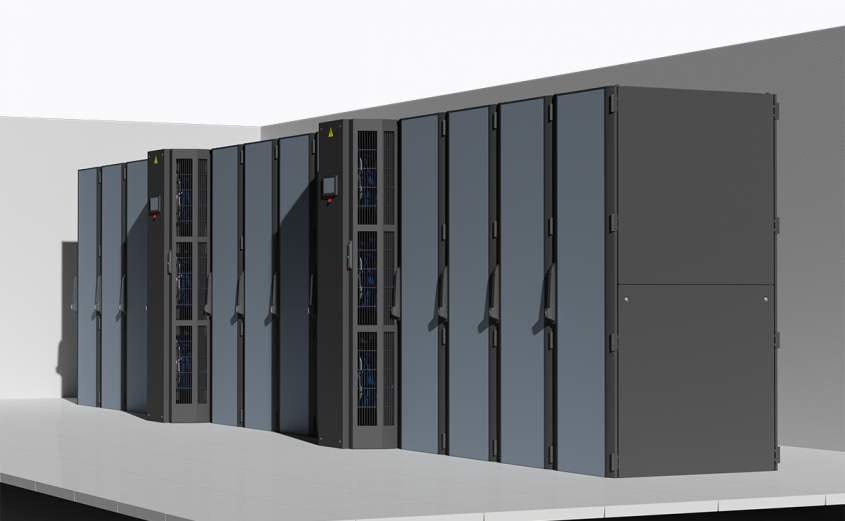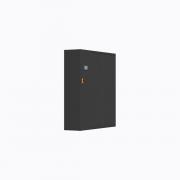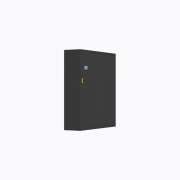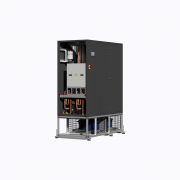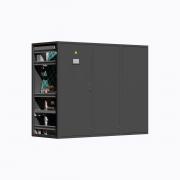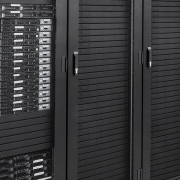Aisle containment as an approach to data center cooling
For decades, data centers have used raised floor systems to deliver cooled air to the server racks. Cooled air discharged by a computer room air conditioner (CRAC – a split air conditioning system or system with fluid coolers) or air handler (CRAH – a chilled water cooling system connected to air-cooled or water-cooled chillers) creates high pressure in the underfloor space. This air is direct back to the whitespace via perforated floor tiles. It is then sucked into the server racks and this cools the server equipment located inside the rack. Heated by the servers, the air is returned to the CRAC/CRAH units, usually after mixing with cooled air. CRAC/CRAH units located along the room’s perimeter, resulting in loss of energy for displacement of large volumes of air within the room. Due to the mixing of cold and hot air flows, the room has to be kept at an artificially low temperature. Moreover, open space design with artificially low temperatures provides limited free cooling opportunities.
Thus, raised floors in data centers used to deliver cooled air directly to the racks and permitting reconfiguration of the airflows as required by installing perforated tiles where necessary. Despite the design, cooling systems with underfloor air distribution fulfills its role in traditional, low-density data centers and still used today.
Continuous miniaturization of the processor chips leads to exponential growth of power densities in today’s data centers, and many data center operators face the challenges in air distribution and organizing the airflows. Poor efficiency and uneven air distribution are inherent in traditional cooling systems and unacceptable in the reality of modern data centers.
By using an aisle containment design, a physical barrier which separates the cold air supplied to the server racks and hot exhaust air enables the problem of mixing hot and cold air flows to be addressed. The benefits of aisle containment design are a possibility to raise the supply air temperature, higher ∆T which makes the cooling system more efficient and serving higher power density.
There are two configurations of contained environments: cold aisle containment, where cold air from CRAC units is contained, while hot server exhaust air is allowed to return freely to the CRAC, and hot aisle containment, where the hot exhausted air is contained and returns to the CRAC for cooling.
Cold aisle containment is generally less expensive and easy to use and typically easier to fit in an existing facility. At the same time, this method is more suitable for facilities with a constant IT load and consistent arrangement of rows of racks.
Hot aisle environment requires in-depth work to arrange overhead ductwork. At the same time, it offers increased flexibility and allows higher power density compared to cold aisle containment design. CRAC units flood the room with cooled air which is sucked by each individual server rack as needed, while a cold aisle containment arrangement is not so flexible and may require relocation of perforated tiles with a change in server loads.
The problem of long air paths and energy waste for its delivery to and from the server racks can be overcome by using close-coupled cooling. At the aisle level, an in-row unit installed within the row of server racks delivers cooled air directly to the front of server racks and sucks air from the back. Cooling doors comprising of the heat exchanger, fans and controls housed in a rear door (or replaces it) of server rack can handle extremely high power densities but has significant redundancy issues: in the event of failure, IT equipment will be exposed to the risk of overheating.
A close-coupled cooling system design offers additional strengths when used in conjunction with cold aisle containment. Since air streams take the path of least resistance under the floor, using convenient CRAC units leads to the incorrect distribution of cooled air between the contained rows. Close-coupled cooling systems, such as in-row units, help to avoid uneven air distribution, and, at the same time, reduce fan energy.
Aisle containments enable broad free cooling opportunities due to increased air supply temperatures. Modern free cooling chillers operate with high water temperatures and high ∆T, thus increasing economization hours of the free cooling system and providing significant energy savings.
Aisle containment architecture creates a predictable and uniform airflow, substantially reduces fan energy for air movement, eliminates hot spots, enables higher supply air temperatures and increases opportunities for free cooling. The choice between hot aisle and cold aisle containment should be determined by assessing specific data center restrictions. Cold aisle containment is preferred for facilities with the raised floor as a supply air plenum, as well as for retrofit applications, while hot aisle is preferred for new installations or for the facilities where IT loading is not constant. In both cases, the close-coupled cooling strategy is preferable.
Kaltra is a world-known provider of cooling technologies and advanced cooling products for mission-critical applications, such as data centers, clean rooms, contaminant-free areas, processing plants, and other facilities where reliability and energy efficiency are key factors. Kaltra’s cooling equipment range includes precision cooling systems, air-cooled and water-cooled chillers, evaporative cooling solutions, dry coolers, and condensers.
For more information on Kaltra and its products call +49 911 715-32021
or visit www.kaltra.de

